Hernia treatment is conservative and surgical methods. The choice of method of treatment depends on the type of the defect, patient’s age and presence of systemic diseases.
Umbilical hernia is a pathology in which the internal organs (omentum and intestine) are outside the abdominal wall through the umbilical ring. Often this phenomenon occurs in pregnant women and young children.
The main cause of the herniation is weakness of the abdominal muscles and connective tissue in the defect area.
Reasons
This increase in intra-abdominal pressure leads to a protrusion of loops of intestine and omentum through the umbilical ring. In this case, the pathology is called acquired. A congenital disorder manifested immediately after birth.
Congenital
The formation of congenital hernia, the protrusion occurs in the early stage of embryogenesis (embryonic hernia) or in the 1st trimester of fetal development (human umbilical, embryonic hernia).
Embryonic pathology is a loss of internal organs due to developmental disorders of the anterior abdominal wall. This phenomenon is often accompanied by the following defects:
- the splitting of the sternum, the palate and the face;
- underdevelopment of the bladder wall and the pubic articulation;
- the absence of anus;
- congenital heart defects etc.
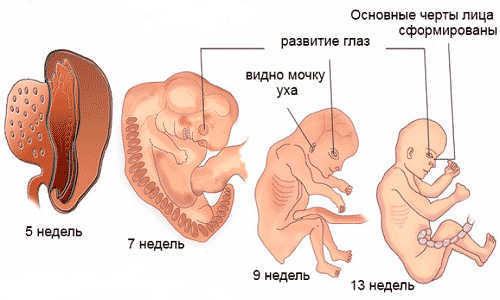
Congenital hernia of the umbilical cord occurs due to the delayed development of the abdominal wall, not its embryonic pathology. Through the umbilical cord protrude not only loops of bowel, but also part of the liver.
Purchased
Acquired hernias often develop in the first months of life. The occurrence of a defect associated with a slow process of obliteration (imperforate) umbilical hole. A possible reason for the delay can be a weakness in the abdominal muscles, which should further tighten the circle.
If the imperforate process is not complete, even not too much increasing intra-abdominal pressure may cause protrusion of organs in the hollow space around your belly button.
In addition to the slow obliteration of predisposing factor for the formation of a hernia in a child may serve as a genetic weakness of the connective tissue of the peritoneum. If the hernia was observed in at least one of the parents, with a probability of 70% the defect is discovered and a baby. A risk factor is prematurity: babies born prematurely, pathology is observed 1.5 times more likely than term infants of the same age.
In women a hernia develops more often than men. The reason for the gender imbalance is a stretching of the connective tissue of the umbilical ring and reducing its resistance intra-abdominal pressure during pregnancy.
Pathological the tension of the connective tissue can occur with obesity and the presence of scars.
Increased intra-abdominal pressure can be caused by the following factors:
- strong crying and screaming (newborns);
- overexertion during exercise;
- chronic constipation;
- ascites (accumulation of effusion in the abdominal cavity);
- pregnancy;
- pathology, characterized by a prolonged severe cough.
Symptoms
Symptoms of a hernia are:
- A soft elastic protrusion of the navel. At loss of bowel loops during palpation of education is felt that the liquid and rumbling.
- The increase of convexity at a voltage of abdominal muscles, crying, coughing, etc.
- Extension of the umbilical ring. After reposition of the hernia it is easy to introduce the tip of your finger.
- Weak pulling pain radiating to the abdomen and back. A sharp pain is evidence of the infringement.

While squeezing the contents of the hernia SAC at the narrow gate gruzevich there are also nausea, vomiting and intestinal obstruction.
Diagnosis
If you suspect a hernia you must contact the surgeon. The doctor collects history, examines and palpated defect.
To study the protrusion of the following methods:
- herniography (radiography of the defect with contrast injection);
- ultrasound diagnostics of the bulge and the abdominal cavity;
- esophagogastroduodenoscopy (EGD).
With the purpose of differential diagnosis the patient is assigned to a separate x-rays of the digestive tract (stomach and 12 duodenal ulcer).
Following the examination, the surgeon determines the type of hernia and the necessary treatment (conservative or surgical).
Classification
Gryzenia of education are classified according to the following criteria:
- the origin (congenital, acquired);
- the location features (oblique, direct);
- the possibility of displacement relative to the abdominal wall (upravene, irreducible).

Direct hernias arise in the thinning of the transverse fascia.
When the defect in the oblique inguinal hernia treatment type bag is formed under or over the umbilical ring, passes between the transverse fascia (connective tissue sheath) and the white line of the abdomen, and then push through the ring.
Direct hernias arise in the thinning of the transverse fascia. In this pathology of the internal organs out into the subcutaneous tissue directly through the navel ring.
Possible complications
Complications of hernia include the following phenomena:
- infringement of the bodies that were outside the abdominal wall;
- inflammation of the contents of the hernia SAC;
- damage and necrosis of the bowel, omentum and other organs inside of the defect;
- mechanical intestinal obstruction (koprostaz).
If not timely to go to a surgeon, the patient develops peritonitis (inflammation of peritoneum), which can lead to death.
Embryonic pathology is often associated with multiple birth defects, which significantly reduce the viability of the newborn. Internal organs when such defect is located in a thin shell, which can rupture during birth or in the first hours of a child’s life. In this case, the infection of the peritoneum and the development of severe peritonitis.
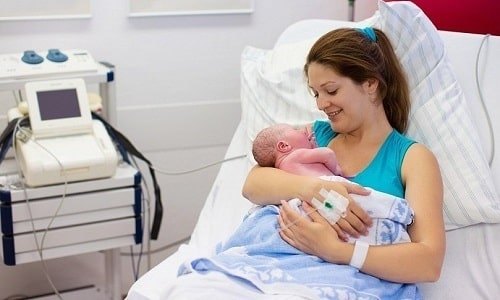
With an umbilical hernia there is a high probability of inflammation of the peritoneum, so children with this defect shown urgent radical treatment in the first hours of life.
Treatment
Conservative methods are used not only to treat hernia but to its prevention and recovery after hernioplasty (removal of a defect). In non-surgical therapy uses the following tools:
- medication;
- physiotherapy and massage;
- mechanical contraction of the umbilical ring (band, patch);
- diet;
- popular recipes;
- physiotherapy.
Umbilical hernia in adults does not resolve using conservative methods, surgical intervention is necessary.
Medicines
Medications help ease the unpleasant symptoms of the hernia of education and prevent its development (e.g., constipation).
Drink them without consulting a doctor is not recommended.
The patient may be given the following tools:
- analgesics and antispasmodics (Spazmalgon, Baralgin, Ketanov, But-shpa);
- laxative (Duphalac, But, Laxation).
With nausea and vomiting should immediately contact the surgeon.
Physical therapy
The main method of physical therapy for the treatment of hernia is a firming massage. It improves blood circulation in the region of the weakened tissues, restores muscle tone and helps build the digestive tract.
In the technique of massage uses stroking, pinching and rubbing the umbilical region. The procedure should be performed by a specialist, because improper execution of movements can aggravate the stretching of the navel ring.
Physiotherapy is also used during rehabilitation after hernioplasty. During the recovery period effective ecoterapia, electrophoresis, UV-treatment.
Bandage
Brace (corset) is a device that helps to support the abdominal wall and redistribute the load at the umbilical ring, which prevents excessive stretching. Medical corsets are recommended to wear for pregnant women and people who regularly lift weights.
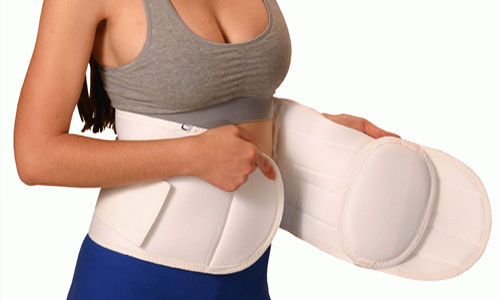
The patchHernia bandage is used in preparation for surgery, during rehabilitation and in the presence of contraindications to plastic surgery of the defect. To pick up medical corset needs attending.
For reposition of the hernia and mechanical umbilical retraction holes have small children, you can apply the patch. The surgeon carefully sets the defect, forming 2 small folds of skin (top and bottom of the navel), and positions them to create a mechanical obstacle to the exit of the internal organs of the hernial orifice. After this procedure the skin folds together a solid band-aid.
A bandage is applied for 4-10 days with a break for 2-5 days or only during exercises and massage.
Feeding habits of a hernia
Dietary therapy for Grajewo the protrusion is directed to the prevention of constipation and flatulence. During treatment, observe the following rules:
- eat 4-6 times a day in small portions;
- to consume at least 2 liters of fluid per day;
- eliminate carbonated, caffeinated and alcoholic drinks, legumes and soy;
- to limit the use of confectionery and bakery products, fatty meat and dairy products, some fruits (apples, grapes, plums);
- to increase the proportion of fruits, vegetables, cereals, excluding rice, potatoes, carrots and asparagus.
Folk remedies
Traditional methods of treatment should be used only after consulting a surgeon or pediatrician.
Effective are the following tools:
- Psyllium seed. To strengthen the muscle and connective tissue traditional healers recommend daily use 0.5 tsp of seeds.
- A poultice of roasted onions. For preparing the funds necessary to roast the onion, cut it in half and attach to the navel for half an hour.
- Appliques with red clay. For making a compress, dilute the clay with water to the consistency of porridge, then spread on a gauze and attach to the protrusion.
Physiotherapy
To correct the hernia and prevent any useful physical activity aimed at strengthening the abdominal muscles. Therapeutic exercise is performed under the supervision of a physiotherapist, which takes into account the level of training, age and health status of the patient.
If you experience pain during exercise physical activity is reduced or abolished. Swelling and severe pain in the region of the defect physical therapy is strictly prohibited.

To strengthen the muscles of the abdominal wall in infants practiced putting some kids on the abdomen and special exercises for infants.
Surgery
Surgery is performed according to plan and extra. The indications for elective surgery is age over 5 years or an increase in size of hernia in children of any age. Emergency intervention is performed when complications of the acquired defect and any form of congenital disease.
Open way
With the open method of plasty incision is made below the belly button, inguinal hernia treatment, the bag is released and opened, the internal organs reduce in the peritoneum, and the remaining tissue excised. The incision is sutured.
When carrying out operations apply the technique of Bassini, Liechtenstein, Lexer, Krasnobaeva, etc.
The choice of method depends on the patient’s age, size and location of the hernia.
Hernioplasty can run its own tissue or mesh-implant. The frequency of recurrence of the defect in the operational gastroenterology is around 1% (when using the endoprosthesis).

Laparoscopy
Laparoscopy is a more gentle operation. It is not through the incision, and in 3 small puncture in the abdominal wall through which you enter all the necessary surgical instruments.
Unlike open surgery, laparoscopy is always performed under General anesthesia.
Prevention
To prevent the formation of protrusions should:
- to train the abdominal muscles;
- to avoid excessive physical exertion;
- to wear a jockstrap with hard work and pregnancy;
- to fight obesity;
- timely treat the cause of constipation, excess gas and cough;
- to prevent strong crying and screaming in infants, to use drugs from colic.
Features of the disease
Often the protrusion of internal organs are diagnosed in infancy and during gestation of the fetus.
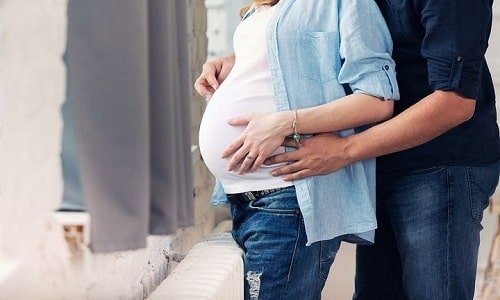
Pupkova hernia in these patients has its own characteristics of flow that affect the choice of treatment and prognosis.
Children
A large part of the hernia in the navel is diagnosed in the first year of life of children. For small defect sizes and the absence of complications, the only sign of pathology may be rounded bulge in the navel area, which is easily reduce on palpation and increases at a voltage of abdominal muscles.
To 5 years shows the observation and conservative treatment, because gryzenia protrusions in children are prone to spontaneous regression.
Infringement of the defect and recurrence of the disease in kids are rare.
Pregnant
Due to the load on belly button ring in pregnant women is frequently observed recurrence of infantile hernia.
Although the hernia has no effect on pregnancy loss intestine disrupts the digestive tract and worsens the condition of women, and complications of the disease (necrosis, peritonitis) can lead to premature birth and miscarriage.

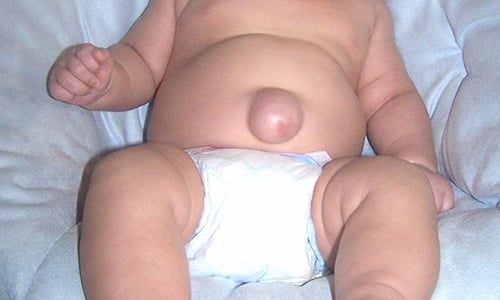


Oh, namaste..
This article gives so much more info than similar blogs, and it’s incredibly helpful to me. Will return to see more writing from you! can I share this?